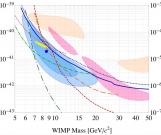Paper of the month: Connecting Direct Dark Matter Detection Experiments to Cosmologically Motivated Halo Models

June 26, 2013 by admin
Connecting Direct Dark Matter Detection Experiments to Cosmologically Motivated Halo Models
Yao-Yuan Mao, Louis E. Strigari, Risa H. Wechsler ( KIPAC/Stanford)
Approximately 85% of the matter content of the Universe is in the form of Dark Matter. Unlike ordinary matter -- composed of particles from the Standard Model of particle physics – the existence of dark matter has only been inferred from its gravitational effects.
However, physicists have good reasons to believe that dark matter should connect to the other fundamental forces (the strong & weak nuclear forces, and electromagnetism; the latter two being connected through what is called electroweak theory). A weak coupling to the standard model implies that dark matter particles, which are constantly streaming through the Earth, should very occasionally strike a particle. By very careful construction, experimental physicists are able to build experiments that can detect the "aftershock" of such an impact. For example, by detecting the vibrations from a nuclear recoil, the electron freed by an ionizing impact, or the scintillation light produced by the collision, they can in principle determine that a weakly interacting massive particle (WIMP) has passed through their detector. From these detections (or lack thereof) we may determine (or exclude) two key parameters about the dark matter particle: its mass and interaction cross section. Putting together results from various experiments, we obtain graphs such as the following, which shows exclusion limits or favored regions in the cross section versus mass plane:
.jpg)
Image credit: CDMS collaboration, http://arxiv.org/abs/1304.4279
This type of plot is quite ubiquitous in the dark matter community, and on the surface seems to indicate that 1) several experiments (i.e. DAMA, CoGeNT, CRESST, and recently CDMS-II) seem to have detected hints of low mass dark matter particles; and 2) these detections should not have been possible, due to the non-detection by other experiments - notably XENON100.
This is an incomplete story, however. The key is that behind these graphs are several assumptions about the distribution of dark matter in space, as well as the velocity of individual particles and even the way in which the particles interact with the standard model. These assumptions are collectively known as the "Standard Halo Model" (SHM).
This paper examines one of these assumptions -- the velocity distribution -- and shows that it actually has a large implication on what one infers about the properties of dark matter.
In the SHM, the velocity distribution function (VDF) is assumed to be a Maxwell-Boltzmann distribution - the same distribution followed by gases that we encounter every day. However, cosmological many-body simulations find that the VDF of dark matter halos are quite different from the Maxwell-Boltzmann shape. In the analysis of direct detection experimental data, it has been common to assume the SHM and not include the uncertainties in the VDF. This is relatively safe for heavy WIMPs of ~100 GeV since the experiments are not sensitive to the variation of the VDF for such WIMP masses. But for low mass WIMPs, the uncertainties in the VDF can have a significant impact on the experimental results.
In this paper, the authors assume a functional form with two parameters for the VDF. Due to the uncertainties in the Milky Way halo model, there are significant uncertainties in the VDF parameters. They identify the range of parameters that are allowed by cosmological simulations, and show that in this cosmologically-motivated parameter space, the tension between the CDMS-II, CoGeNT, and XENON100 results can be resolved.
The authors emphasize that there is not a single preferred set of VDF parameters that experimentalists can use to directly compare results from different experiments. Even when only the cosmologically motivated VDFs are considered, different interpretations of results are possible. They believe that the best strategy to compare different experimental results is to either use a VDF-independent method, or use different parameters in the VDF to show the possible uncertainties. Finally, they conclude that when giving the statistics of signals or exclusion limits, one should marginalize over the VDF parameters which are cosmologically motivated.
In summary, one has to be careful when interpreting results from different experiments while making assumptions about the properties of the local dark matter distribution, since such assumptions can have a large impact on the dark matter properties inferred from the data. This paper nicely illustrates the danger of taking results at face value, without properly considering the subtleties that went into deriving and presenting them.





